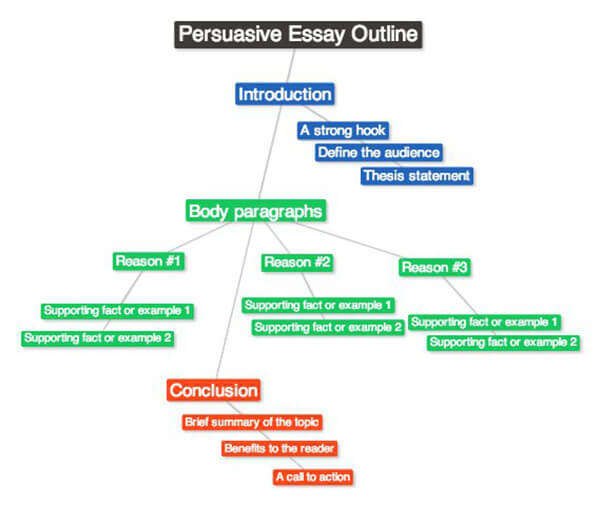Persuasive Essay Definition
A persuasive essay is an article meant to persuade a reader towards a definite notion, view, or focus. In other words, authors use persuasive essays to convince readers to adopt their position regarding an issue or view. It is comparable to an imaginary conversation between the writer and the reader. In one way or the other, the author attempts to persuade the reader to take action or think about something. Henceforth, the persuasive essay writer has visualized how the reader will dispute their arguments and develop answers to the objections. Body paragraphs in persuasive essays have a unique organization. First, the author expresses a counterargument: a likely response to arguments that might emerge from those who will read followed by the writer’s urgings and support. Addressing the readers’ expected wiles first strengthens the author’s position. This reduces critics that could emerge about the article. Besides, it develops a positive attitude towards reading the piece.

Persuasive Essay Tips
In general, a writer’s rationale is very vital in writing a persuasive essay. This is because the author represents self-opinions and tries to win readers to adopt his/her logic. Thus, the most important qualities of a persuasive essay are:
- The author should research the study topic to ensure that his work is convincing.
- It should have a fixed point of view.
- It should have enough substantiation.
- It should uphold the readers’ interests.
- It should employ sound reasoning.
- It should merge the intended audience.
- It should not use too many descriptions in a paragraph that may make the article boring to the public.
- The writer should minimize repetitions.
- It should embrace good paragraphs that uphold the above organization.
- It should end with a firm conclusion.
Writing a Persuasive Essay
Writing a persuasive essay involves the following steps:
I. Persuasive essay topics/ topics for a persuasive essay: Choose a topic, for instance, from a given list and when selecting an item, select a controversial issue. Besides, the author should pick a subject that he/she has sufficient information about. Good persuasive topics are matters that most folks have similar opinions on.
Below is a list of good persuasive topics:
- Should elementary schools teach handwriting?
- Are security cameras an assault on privacy?
- Should guns be allowed in schools?
- Technology has led to an increase in pollution.
- Should parents be liable for what their kids post on social media?
- What means of generating electricity is less destructive to the environment?
- Should all schools be single-gendered?
- What measures should be put in place to control bullying at the workplace?
II. Selecting the standpoint of a persuasive essay: this involves deciding the position you will take as the author. It encompasses determining which side of the matter, problem, or issue at hand as the author you will stand by; henceforth, providing vivid description supporting your view. The step is necessary after picking a topic to discuss. Additionally, one has to consider the solutions available.
III. Evaluate the audience: determine if the projected audience accepts or disagrees with your position. This makes the development of counterarguments easier. Thus, enabling one to move his essay with easy and fast.
IV. Explore the topic. A persuasive essay requisite is an explicit and substantial evidence. Besides, it is compulsory for the writer beyond his/her knowledge. This can be achieved by essayists doing sufficient research about the issue. By either utilizing the library or interviewing experts in the field.
V. Essay structuring. Evaluate the evidence to be included and the order in which it should be represented. Here the author puts into consideration the audience, the topic, and the purpose of writing the essay. Most important the writer should ensure a good and logical flow of information.

For one to produce an effective argument he/she has to uphold the following persuasive essay ideas:
- Research on the issue. Study or investigate the topic to knowledge on the area of study. Read authentic sources comprehensively and make outlines to enhance your understanding of the subject. This strengthens the writer’s position to develop and move an argument.
- The topic of a persuasive essay must be debatable; hence, enabling a good thesis statement. Besides, it makes work for the author easier, for instance, in developing arguments concerning the issue at hand.
- Refute the contrasting arguments in the persuasive essay. Understand your position and protect it with illustrations especially after giving an opposing statement. Henceforth, included but it is the responsibility of the author to adequately refute these sentences ground facts from research and references from other articles. Hence, convincing the reader that his/her stand is viable.
- Back your standpoint with evidence. The evidence must be presented in an appealing manner. This is centered on the writer’s research on the topic. Because it is research that enhances how one understands an issue thus, building confidence in him/her giving descriptions vividly and in a logical manner. Besides, it should be accompanied by references where necessary.
Write a Persuasive Essay
A Persuasive essay writer uses logic and reasoning to demonstrate that his position is more authentic than other notions. It challenges readers to take a particular action or espouse a point of view. Additionally, the argument uses a broad range of perceptions and available evidence. Henceforth, averring realities and providing explanations about the issue by the use of examples and quotes from the experts in that field. Thus, a persuasive essay encompasses a lot of requirements that should be upheld.
Steps in Writing a Persuasive Essay
1. Select a strong, defendable stand for the thesis statement. The thesis statement is an expression that represents the author’s position. It is compressed to one sentence. It has to take a firm standpoint on the study issue. Besides, the author should definite and precise in expressing the statement. Below is an example of a good and bad thesis statement regarding the same issue.
Good: “students’ textbooks should be swapped with tablets or computer notebooks.”
Bad: “students’ textbooks might be swapped with tablets or computer notebooks.”
The good thesis statements persuade readers to back the replacement of students’ textbooks with tablets or computer notebooks. On the other hand, the wrong thesis statement is not exactly what should be done. For instance, it does not clarify what should be adopted between textbooks and tablets but leaves room for the reader to make a decision.
2. The counterargument in a persuasive essay should be clear and relevant. The counterargument is the likely response to the argument that might emerge from the reader. In other words, it is a brief depiction that pushes the reader to accept the author’s views. It is usually in one or two sentences and appears first in Body paragraphs. Examples:
Good: The Federal government should recognize civil unions since the unions support the society in one way or the other.
Bad: The Federal government should recognize civil unions.
The real counterargument statement has the reason why the federal government should recognize civil unions, an aspect lacking in the wrong counterargument.
3. The author should defend his/her arguments via practical evidence, and facts and should back his claims with references. This entails developing good arguments to support his/her position. Besides, the detailed description should back the arguments. Thus, the author’s views should be presented in a clear and logical manner, a style that makes the article, attractive to the reader. Additionally, the writer should cite references throughout the essay, especially, where another person’s or author’s information is used to back the standpoint.
4. The sentences in a persuasive essay should be brief and precise. The author should present a very point in different phrases. This will enhance the capability of a reader to build the argument reasonably. Long and complex sentences heighten the probability of misunderstandings and confusion. These sentences make it hard for the reader to comprehend the message. Hence, brief and precise sentences are necessary for clarity.
5. The author should use a range of persuasive techniques in order to hook readers. These methods include repetition, social validation, and problem agitation. Repetition is the process of using various facts in verifying that the author understands the study issue. Henceforth, frequently the author focuses on his/her position but from a different angle. For instance, the writer justifies his/her stance with a variety of arguments. Social validation is when the essayist quotes from previous articles to support his/her opinion. This conveys that it is not only the author making the point. Besides, appropriate citations should follow these quotes. Problem agitation refers to the manner in which the writer brings out the problem. First, the author should state the problem then illustrate its impact and provide the possible solution. Besides, the illustration should include reasons for taking essayist’s argument into consideration.
6. The Author should be authoritative and Firm in the persuasive essay. To make an essay trustworthy, the writer must be professional, especially when expressing self-views. These entail the process of cutting out indecisive phrases to escalate the tone of authority.
7. The author should recognize and counter-arguments against the standpoint in a persuasive essay. It involves the process of defending the writer’s viewpoint. After a review of the essay, the author might realize some counterarguments that can raise against his/her position. These perceptions have to be acknowledged and refuted in the article.
Persuasive Essay Format/ Persuasive Essay Structure
A. How to start a persuasive essay?
When writing a persuasive essay the introduction is the first part. It begins with a “hook,” a phrase that catches the reader’s attention. The hook or grabber is a short statement that reflects what the article includes. It can have one or two sentences. Some “hooks” comprise:
- Opening with an unfamiliar facet: for example, Manhattan, due to its cold climate, is not considered an ideal place for reptiles. Truly, it has the largest seasonal population of garter snakes in the universe!)
- Starting with a solid statement: for instance, imagine domain polar bears.
- Starting with a Quote: (William Shakespeare once said that “it is not the star that holds our destiny but ourselves.”)
- Beginning with a Yarn: A yarn can offer a witty and attention-catching opening clause. For instance, gender discrimination in the place of work is escalating, but it is hard to verify. It should be brief and precise.
- Starting with statistical data or a fact: statistical data or facts make your essay stimulating; thus, opening with them can catch the eye of the reader. For example, bestowing the centers for disease control and Prevention (CDC) data, one in sixty-eight children is having autism, as per 2016 statistics. However, referencing is necessary under these conditions.
- Beginning with a question: the question drives the reader to give answers. Thus, through it, the author can catch the reader’s interest. For instance, should the breweries be allowed to advertise through social media?
- Opening with hyperbole. A hyperbole gives the reader feeling of the article hence stimulating him/her to read more. For example, teachers should wear uniforms.

The persuasive essay thesis or focus statement is also part of the introduction. The Thesis is the author’s statement of purpose. It is usually one sentence in length. It is the essay foundation and serves as a guide to the writing of the piece. The primary intentions of a focus statement are:
- It states the disputes the article will address.
- It manages the author on how he/she will tackle the topic.
- It regulates the organization of the essay.
The thesis is supposed to give the reader thoughts on the topic and the position of the writer. Besides, it acts as an overview of the article; thus, has to bring out author’s argument clearly. Lastly, the introduction takes into consideration three things; these are the topic, the author’s position, and the audience. Hence, considering these facts the writer draws the reader’s attention to his/her viewpoint. Thus, an excellent introduction catches the interest of the reader
B. The Body of a Persuasive Essay
Here the author provides evidence to support the thesis statement. The body consists of more than two paragraphs. Paragraphs back the focus statement with solid reasons. A good persuasive essay incorporates both sides of the argument, but, after an opposing perspective, the author as provides a counterstatement. Besides, one paragraph should focus on counter-argument. Body paragraphs in these theses have a unique organization. First, the author expresses a counterargument: a likely response to arguments that might emerge from those who will read followed by the writer’s urgings and support. Addressing the readers’ expected wiles first strengthens the author’s position. This reduces critics that could emerge about the article. Besides, it develops a positive attitude towards reading the piece.
C: How to Write a Conclusion for a Persuasive Essay/ how to End a Persuasive Essay?
A persuasive essay usually ends with a summary of the most important facts in the article. Additionally, it restates the author’s position on the issue addressed. Hence, the right conclusion includes:
a) Summary of the essay: the conclusion should give the reader a view of the article. It should make the reader remember the key points supporting your standpoint.
b) It should also restate the focus statement.
c) It should include a call for action or personal comment. For instance, it should end with:
- A Question: concluding with a query gives readers an opportunity to make a prediction or a conclusion.
- A Quotation: ground on the fact that a quotation may be a call for action, a comment, a prediction, or a summary; authors can end with a quote in any paper.
- A Prediction: this is applicable where the narrative causes predetermined consequences. Thus, a conclusion may forecast the expected outcome.
- A Recommendation: A recommendation conclusion calls for action, expressly protection from a threat.
Persuasive Essay Outline
How to write a persuasive essay outline/ guideline for persuasive essay writing:
The introduction of a persuasive essay
The introduction should:
- Catch the reader’s attention, for instance, by using a right hook.
- Should present background.
- Includes the thesis statement.
The body of a persuasive essay
In the body, each paragraph starts with a counterargument followed by an argument and ends with support sentences.
I. The first paragraph of a persuasive essay; include evidence to support your standpoint:
- The first sentence explains the author’s position and the reason behind the attitude.
- Followed by the probable concession towards the counterargument.
- Next, is an elaboration to back the writer’s position?
- Lastly, the paragraph ends with a clincher.
II. The second paragraph of a persuasive essay gives another reason supporting the author’s view.
- The topic sentence explains another reason behind the perception.
- Followed by the probable concession towards the counterargument.
- Next, is an elaboration to back the writer’s position?
- Lastly, the paragraph ends with a clincher
III. The third paragraph gives a reason to support your position:
- The topic sentence explains another reason behind the perception.
- Followed by the probable concession towards the counterargument.
- Next, is an elaboration to back the writer’s position?
- Lastly, the paragraph ends with the clincher.
IV. The fourth paragraph takes into account opposing viewpoints:
- Starts with a counterargument.
- Followed by a rebuttal to the counterargument.
- Next, is an elaboration to back the rebuttal?
Persuasive Essay Conclusion
The conclusion includes a summary of the main points in the essay, a call of action, or a prediction and usually restates the thesis statement. Additionally, the conclusion should take the essay one step further. It should answer any unclear issues that may arise from the critique and end the piece with a bang. The following are examples of conclusions.
Example 1: Impacts of Social Media on America’s Youths.
Social media allows youths to connect with the public across the world. However, it has come with lots of impediments. That ranges from inaccurate information to cyberbullying. Time wastage and hacking in chatting are also included. Social media has been beneficial, but the bad can at times outweigh the good; hence, it is time to come up with better strategies to enhance the responsible use of social media.
Example 2: College education should be free?
The rise in student loan debt is a clear indicator that something is wrong. Besides, it is true that universities need something to help the institutions learn smoothly; however, getting a college education should come at no direct cost to learners. A free college education should enhance nation’s education as a whole. It should leave undergraduates with more time to work on their studies not on jobs to pay the fee. Hence, students should become more creative; thus, making the US one of innovative countries in the world.
Persuasive essay phrases
The phrases include: at the same time, In other words, first, to be exact, after that, for instance, besides, besides, in spite of this, nevertheless, in contrast, in summary, at last, and however. Examples of usage in sentences:
- First, the author expresses a counterargument: a likely response to arguments that might emerge from those who will read followed by the writer’s urgings and support.
- Besides, it makes work for the author easier, for instance, in developing arguments concerning the issue at hand.
- Additionally, the argument uses a broad range of perceptions and available evidence.
- Henceforth, averring realities and providing explanations about the subject by the use of examples and quotes from the experts in that field.
